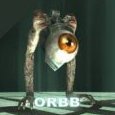
Leaderboard
Popular Content
Showing content with the highest reputation on 01/02/2021 in all areas
-

Traps in video games
StaceyPowers reacted to Withywarlock for a topic
It's because I'm not a fan (yet, I hope) that I'm reading his work. I've had this Commemorative Edition of Necronomicon: The Best Weird Tales of H.P. Lovecraft, unread for so many years (about 11 now) that I'm giving it another chance. I'd finished Call of Cthulu (2018) a few days back, so impressed was I that I wanted to see how it was compared to the book. I had intended to read the eponymous story but was so glued to the game that I couldn't make time for the original work. So that, and quite possibly Call of Cthulu: Dark Corners of the Earth if you've the stomach for a slightly older FPS. And if you're into the tabletop I've heard many good and frightful things about the Call of Cthulu RPG by Chaosium Inc., as well as Achtung! Cthulu. What I'd give for Cthulu Invictus, the Ancient Roman Cthulu RPG book.... Ahem. The Dark Conspiracy tabletop RPG would also support Lovecraftian stuff well I think, being Near-Future and containing supernatural phenomenon and the like. We Happy Few sort of has Lovecraftian vibes to it, but is more steeped in an Orwellian, Invasion of the Bodysnatchers and Doctor Who: The Happiness Patrol/Jubilee influence than Cthulu as such.1 point -

Traps in video games
StaceyPowers reacted to Withywarlock for a topic
Like many aspects of video game design, traps are only as good as FARTing. Which is to say, Finding and Removing Traps. I'm currently playing We Happy Few, which has a few problems: Scarcity. Encounters with tripwires are far and few between. This means that when they come up they feel like they're a cheap way of taking a liberal chunk of the player's health away. Now some of these are hidden by darkness and the player can be blamed for not having a torch, which, err, sees too little use to be considered than going in somewhere new fumbling in the dark. "Disarmament". Disarming traps in We Happy Few almost always means either jumping over them (to surprising effectiveness), or sprinting through them thus activating them (an exploded bomb is technically disarmed) and either taking damage or.... not. Disarmament. If you're unfortunate enough to have any content left over by the time you get the Multitool required to disarm traps properly, then you'll have to hold down the X button to do so like when you've got several lockers to use the lockpick on, or a few planks of wood boarding up an entrance to be broken with your jimmy bar. It's another pain for the player to deal with it on top of the misery of (what will probably be) an extra 40 hours of that. Because of the nature of We Happy Few (a first person "immersive sim", or to use a less masturbatory name for the genre, a "0451" game) the player has the advantage of seeing traps for themselves. Compare this to something like Baldur's Gate, an isometric Computer Roleplaying Game (CRPG) based on the Advanced Dungeons & Dragons 2nd Edition (AD&D 2E) ruleset. In Baldur's Gate, the most capable member of the party should be FARTing at all times outside of combat, which will run a scan once every six seconds to find any traps within the vicinity. The more points they have in the skills that aid in their detection of traps, the more easily they will come up and can be attempted to be disarmed. Successful disarmament means it doesn't blow everyone to kingdom come; unsuccessful disarmament at best means the situation doesn't change, and at worst it means it's time to reload your last save because who wants to carry the remains and loot of your party member to the nearest temple? Not my Lv. 4 Dragon Disciple Sorcerer. It's important to note that in D&D traps are essentially written as "you find it or you don't / you disarm it or you don't", and it takes great enginuity on the Game Master's (GM) part to make them better than that. Otherwise every single room in every single dungeon is going to begin with the Rogue saying "I look for traps", which is canonical (read: tiresome) a phrase as "I have Darkvision". So, how do we build a better man trap? Consistency. Ironically this is something of a trap itself, like a bomb that only arms itself upon going beyond a speed limit. Going below that speed limit means only one thing: kaboom. When a trap is introduced to a game, it must then either feature heavily (exclusively or almost exclusively) in that level, or traps have to appear every so many hours/dungeons. Think of it as the Start-to-Crate review system: forgetting you have traps and then add them later on to fill space shows a lack of imagination. Senses. How does one FART? Do we see a tripwire? Does our character make a sniffing sound? Do we hear a ticking noise that's gradually speeding up? How we find a trap is just as important as the trap's effect itself. The Dance of Death. It's important that players are equipped with the means to deal with traps the moment they encounter them, unless it's made clear before such lethalities that backtracking to get to goodies seen earlier is expected. Backtracking is a fundamental part of surviving We Happy Few, so the Multitool fits in to the mediocre interfacing that is one of the game's defining characteristics. However, it comes so late in the game that backtracking at that point is miserable. Don't make your backtracking miserable - give the player the tools early on enough that they can easily retrace their steps, but not so early that they feel they're just being yanked around for the Hell of it. The Dance of Death (Again). Supposing you're not making a game with backtracking though. Disarming traps shouldn't be the only way to make it past something, especially if disarmament is a minigame. The minigame, like everything else in the game, should be fun. Not everyone else likes minigames like I do though, so it's important that if the player can't do it there's an alternative way that uses their character skills rather than player logic skills. Something like a crawlspace they need to uncover, or enemies they have to plough through. They should have to do something to progress, if indeed the trap is preventing progress. Consequence. One problem with traps is they're just annoying. Health can be healed, and keeping me in place for several real time minutes because I continuously fail my dexterity saving throw (every CRPG with a web spell ever) causes irreversable damage to my opinion of the game going forward. You can go with stat losses and semi-permanent damage that can only be healed by something like an Injury Kit or a Surgery skill, but again that's a problem that goes away. What isn't as easily healed is pride. The trap might be harmless to the player, but not the safe they're trying to crack, which destroys the contents inside of it. Their perfect stealth run can be ruined by the crushing of glass beneath their feet, alerting the nearby enemies. An explosion doesn't have to harm the player, but an explosion usually means danger to all inside the dungeon, does it not? Reward. Like what I'd said about dungeons in another post of yours, traps don't come from nowhere. They are built with purpose. Whether to catch food or trespassers, or simply for the sadistic pleasure of watching someone weep as their precious goodies end up being melted away in jar of acid, they are borne of someone's enginuity, time and resources. People typically don't trap something unless there's value, or they've had something of value taken from them. How many people buy security cameras after they've been burgled, for instance? I'd be surprised if there were that many, because they think it won't happen to them until it does. In order to be burgled though there has to be the idea there's something worth burgling. Think of it from the point of view of the trap maker, however (un)skilled they may be - what would make them defend their property to such a possibly lethal extent? When you put yourself in their shoes, you can end up making the player's reward as good for them as it is for you as a designer. So there's my long-winded thoughts as ever. I should be reading Lovecraft, but I couldn't resist talking about another topic I do so enjoy. For further reading I recommend The Angry GM's "Traps Suck" article, which focusses on tabletop RPG traps but nonetheless begins with how Super Mario World help him appreciate - and deteste - traps, good and bad.1 point -

What makes a dungeon fun?
Withywarlock reacted to StaceyPowers for a topic
This whole response is so above and beyond, and sort of a delicious treat. Thank you. Ironically, there was a bright, sunny dungeon I saw in Skyrim once that I cannot for the life of me identify or locate again, and it's been driving me crazy for years. THIS. The stories woven into the Fallout vaults are awesome.1 point -

1. Milk Before Cereal Or Cereal Before Milk
Reality vs Adventure reacted to The Blackangel for a topic
The soggy outcome is that we were under the rule of a god damn nazi for four long miserable years, and our country was destroyed. The economy tanked, violence skyrocketed, millions were forced well below the poverty line when they had been middle class prior to Adolf. Healthcare was revoked. Equalities that the Obama administration had implemented were almost all revoked. We were a hairs breath from being nuked on a daily basis from North Korea. Adolf went out of his way to try to incite WW3, which surprisingly didn't work. All of our allies abandoned us. Even our closest. Millions moved abroad. The only ones that we had any relationship with was, surprise, Russia.1 point -

What's the Best Modern Urban City Scenery In Game
Reality vs Adventure reacted to Withywarlock for a topic
I'm currently playing We Happy Few set in England's swinging sixties, or slumming sixties if you're a Downer. You don't want to be a Downer, do you? Take your Joy. Not got any? You'd best run off to one of those repurposed telephone boxes and get yourself some from the Mood Booth. I hear there's a new Coconut flavour coming out. Here, why do the Mood Booths say "telephone" on them? I.... can't remember. Not that I need to. Well, is that the time? I'm due for my Joy. Vanilla this time, my favourite!1 point -

Movies you just hate.
Reality vs Adventure reacted to Peterlight for a topic
Yeah well said @reality vs adventure. Have you watched " like stars in the sky". It's another movie that shows pity, I just wish there could be a movie which was done in a simply and normal environment, take for example, something done in a small apartment like you said and maybe someone who doesn't really have anything to offer falling in love with some girl who is only chasing her dreams, real life story. For a change I think the story will be great, no kidnapping, no killing, no death, no get rich by the end, just normal life and nothing more. If I was to think the way most movie producers and script writers think, they tend to make the stories more interesting by starting with a tragedy story and ending in something we all know as happy ending and I can't blame them cos it has been working fine for years and it has turn to a tradition in the movie industry. May be they are just scared of making an entire new movie that doesn't follow the story line and they feel like it's not going to sell or something cos all these fake stories have sold a lot since the beginning.1 point -

What makes a dungeon fun?
StaceyPowers reacted to Withywarlock for a topic
For all their faults, Bethesda Game Studios have an incredible dungeon design philosophy in the Fallout games. Here are my observations: Purpose. The dungeon isn't there because it's something for the player to do. It has a reason to exist in the context of the world. Schools, factories, towns and Vaults are all reasonable expectations in that setting, and are reasonably expected to provide the following: essential items (food, water, medicine), utilities (crafting materials), or at the very least shelter from the elements and baddies outdoors. Granted, these places should be picked clean but you can always take the goods from the current occupiers. Not every bandit exists solely to be XP fodder (OK, in the video game sense sure, but in lore, they've all got their reasons. In Fallout, the harsh world creates a harsher people). In the Elder Scrolls IV: Oblivion mines are differentiated from caves because of their mineral value and the assets within (boarded up walls, pickaxes strewn around) and their more even surfaces. Believable Structure. See above with location; what does a school look like? It's not going to have spike pits and holding cells. Nor is it going to have an abundance of lockers, a cafeteria, a playground and gym. Without these things you might as well have the spike pits and holding cells. A dungeon never starts out as a dungeon. Even a labyrinthian cave, a natural structure, can still have some logic for why its occupants reside there - is it warm, is it cool, is it spacious, is it cramped, is it near a viable food source or running water? Resident Evils. Who resides in the dungeon, and more importantly, why? As said above nobody wants to live in a dungeon because it's a dungeon; they won't live there of their own accord unless it provides a boon. Are they criminals on the run, or have they got the perfect place to ambush travellers? Is it the only place its nocturnal occupants can sleep? And if there's numerous types of creature living there, how do they survive? Which is the invasive species? Reward. A reward doesn't have to be material, though it can be for those who want to get something out of delving in dungeons. If it is material I always find a cache at the end of hardships (solving puzzles or besting beasties) to be a satisfying conclusion. As a game programming note, make a note that the player has completed the dungeon at least once, even if the loot can respawn. But some rewards are better than the material. Again, see Fallout and the odd Elder Scrolls cave - nearly all of them have a story via audio logs, diaries, or environmental assets such as bones or locked rooms with gas or water leaking from underneath them. I couldn't tell you of any weapons I've found in any of these dungeons, but I can tell you of the elections you didn't want to win of Vault 11, or the inescapable island where Bravil's debtors end up. That just about covers the fundamentals of what I think is good dungeon design.1 point -

What makes a dungeon fun?
StaceyPowers reacted to Reality vs Adventure for a topic
So much gore and torture you can smell it through the tv. Walk by recently used torture devices with matted insides some of which are still dripping. And that dripping never stops. You can always hear it. Faint voices of screams that are on its last round of echoes. The sound of chains dangling in the silence from an unknown breeze. Hot inferno in one chamber, and cold ghostly chill in another. Bones and limbs laying around as if kicked to the side like garbage, or fallen from a cart of bodies. Growls from creatures that are somewhere, and every turn you anticipate the worst. Cold stone walls and hooks dangling from ceilings. Big roaches and rats scurry. A maze you can't get out, with endless sights of death to see. And that is all just the surface, till you go down another level. You might as well be in hell. Because your soul is now forever changed. Hallucinations has you tormented, making you a raving lunatic. You find yourself naked on the cold bloody floor, weakly crawling as each breath is the last. Mad demons laugh at you all around. The world is spinning. You finally can walk and stumble around delirious. Head spinning. Bodies dangling. Axe chops. Chops. Then you make it to a quiet chamber to collect yourself. And the exit is not a door, but a psychological puzzle you have to solve in order to escape the dungeon. And you then wonder if any of it was real. Flashbacks haunt you. You begin to think you are dead. Turns out you never made it out of the dungeon, and that quiet room was just a teaser. Now you have to run, cause the monsters are there for real. And you run not knowing where you are going, just running through the maze. Hiding, running some more. Then you wake up and it all seems like a dream. Because it is. You are still in the dungeon after getting knocked out. Now you are strapped down. And the torture begins. Non pain torture first. And you have to figure out a way to get yourself free and run again.1 point -

What makes a dungeon fun?
StaceyPowers reacted to The Blackangel for a topic
First off, a good reason to even enter, preferably on an optional basis. Second, a changing setup instead of sticking to one theme for the entire dungeon. Third, multiple variations of enemies to face including unique enemies only found in said dungeon. Fourth, consequences to all choices. Both positive and negative consequences. Fifth, a justifiable level of difficulty. Not a cruel difficulty level (Zelda ROM-hacks) but not something so easy it could be played in your sleep. Something that easy typically offers no entertainment, as there’s no accomplishment. It’s why there are several of my favorites that I burn out on extremely quickly. I’m too good at them because I’ve played them so damn much. But above all, a good challenge, and a sense of accomplishment afterwards. An item or treasure is always great too.1 point -

Anyone else feel like they are living in cuckoo land?
StaceyPowers reacted to killamch89 for a topic
You're right. After studying all the living organisms on this planet for some time, they'd come to the conclusion that we're the most illogical beings in existence.1 point
